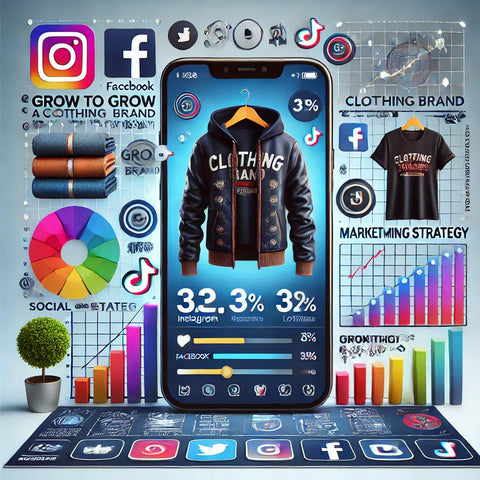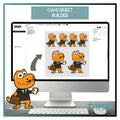A well-designed product catalog is a powerful marketing tool that can showcase your products effectively, enhance your brand image, and increase sales. Whether you're selling printed apparel, accessories, home decor, or DTF transfers, an aesthetic and well-organized catalog can significantly impact how customers perceive your brand.
But how do you create a visually appealing and functional catalog that grabs attention and encourages purchases? In this guide, we’ll cover proven design techniques to improve your product catalog, whether for print or online use.
1. Why a Well-Designed Product Catalog Matters
Your product catalog serves as a visual guide that helps customers understand what you offer and why they should buy from you. A good catalog:
✔ Builds trust – Professional visuals make your brand look more credible.
✔ Increases conversions – A clear, engaging layout makes purchasing easier.
✔ Enhances brand recognition – A consistent design reinforces your identity.
✔ Simplifies product discovery – Well-organized sections help customers find what they need.
📌 Example: A visually rich, easy-to-navigate catalog can increase customer retention and boost sales by up to 20%.
🚀 Pro Tip: Whether designing a print or digital catalog, focus on clarity, aesthetics, and usability.
2. Choosing the Right Format: Print vs. Digital Catalogs
Before diving into design strategies, decide whether you need a printed or digital catalog (or both).
📖 Print Catalogs (Traditional Approach)
✔ Ideal for trade shows, retail stores, and direct mail marketing.
✔ Offers a tangible experience that digital catalogs can’t replicate.
✔ Requires high-quality printing and professional design layouts.
📌 Best for: Luxury brands, B2B sales, premium products.
💻 Digital Catalogs (Modern Approach)
✔ Cost-effective and easy to update as new products are added.
✔ Can be embedded on websites, emailed, or shared via social media.
✔ Supports interactive elements like clickable links and videos.
📌 Best for: E-commerce businesses, DTF print sellers, fast-changing inventory.
🚀 Pro Tip: Many businesses now combine both—a printed catalog for select customers and a PDF or flipbook version for wider digital reach.
3. Structuring Your Product Catalog for Maximum Impact
A well-structured catalog helps customers browse effortlessly. Here’s how to organize it effectively:
🔹 1. Start with a Cover that Grabs Attention
✔ Use bold visuals and your brand logo prominently.
✔ Keep the headline simple yet engaging (e.g., "2024 Custom Apparel Collection")
✔ Include a call-to-action (CTA) (e.g., “Shop Now” or “Exclusive Deals Inside”).
🔹 2. Organize Products into Clear Categories
✔ Group similar products together (e.g., T-shirts, hoodies, accessories).
✔ Use color-coded sections or dividers for easy navigation.
✔ Add filters for size, color, or material to simplify choices.
🔹 3. Feature a Well-Designed Table of Contents
✔ Helps customers quickly find specific products or categories.
✔ Include page numbers, product highlights, and special deals.
🚀 Pro Tip: If designing a digital catalog, make each category clickable for easy navigation.
4. Using High-Quality Images & Mockups
📸 Your product images define your catalog’s visual appeal.
Best Practices for Catalog Images:
✔ Use High-Resolution Photos – Blurry images look unprofessional.
✔ Include Multiple Angles – Show front, back, and close-up details.
✔ Use Lifestyle Shots – Display products in real-life settings.
✔ Show Customization Options – Highlight different colors, sizes, or print placements.
📌 Example: If selling custom DTF-printed hoodies, show flat-lay, model-worn, and close-up texture shots for a comprehensive product view.
🚀 Pro Tip: Use mockups to showcase design variations without photographing every single version.
5. Writing Clear & Persuasive Product Descriptions
Well-crafted descriptions add value and help customers make purchasing decisions.
What to Include in Product Descriptions:
✔ A short, engaging title (e.g., "Premium Cotton Oversized T-Shirt")
✔ Material & Fabric Details – Helps customers understand quality.
✔ Key Features & Benefits – What makes it unique?
✔ Care Instructions – Avoids confusion post-purchase.
✔ Pricing & Discount Information – Clearly display any deals.
📌 Example:
❌ Bad Description: "Soft hoodie available in different colors."
✅ Great Description: "Our ultra-soft fleece hoodie, crafted from 100% organic cotton, offers exceptional warmth and comfort. Available in 5 stylish colors, this hoodie is perfect for casual wear or layering on chilly days."
🚀 Pro Tip: Keep descriptions concise but detailed enough to answer key customer questions.
6. Enhancing Readability with Smart Typography & Colors
📖 Good typography and color choices improve readability and visual appeal.
Typography Tips:
✔ Use a clean, readable font like Montserrat, Lato, or Helvetica.
✔ Keep headlines bold and descriptions slightly smaller.
✔ Ensure a consistent font hierarchy for easy navigation.
Color Scheme Tips:
✔ Stick to your brand’s color palette for consistency.
✔ Use contrasting colors for readability (e.g., dark text on a light background).
✔ Highlight discounts & special offers in eye-catching colors (e.g., red, yellow).
🚀 Pro Tip: Use icons and bullet points for better content organization.
7. Adding Interactive Elements for Digital Catalogs
For online catalogs, interactive features can improve user engagement.
Must-Have Features for Digital Catalogs:
✔ Clickable Links – Direct to product pages or checkout.
✔ Embedded Videos – Showcase behind-the-scenes footage or tutorials.
✔ Zoom-In Functionality – Let customers view textures and details.
✔ Searchable PDF Format – Helps users quickly find specific products.
📌 Example: A "Shop Now" button under each product can increase conversions by 30% in digital catalogs.
🚀 Pro Tip: Use platforms like Flipsnack, Issuu, or Adobe InDesign to create professional, interactive catalogs.
8. Finalizing & Optimizing for Print & Online Use
Once your catalog is ready, final checks ensure it’s polished and effective.
✔ Print Optimization:
✅ Use CMYK color mode for print-ready accuracy.
✅ Save in high-resolution (300 DPI) for crisp printing.
✅ Ensure proper margins & bleed settings to avoid cutting off elements.
✔ Online Optimization:
✅ Use WebP format for fast-loading images.
✅ Optimize SEO-friendly filenames (e.g., dtfgo-custom-print-catalog.pdf).
✅ Compress file size for quicker downloads.
🚀 Pro Tip: Always proofread your catalog before publishing to avoid costly reprints or website errors.
Final Thoughts: Boost Your Sales with a Better Product Catalog
A well-designed product catalog is more than just a product list—it’s a marketing tool that can increase conversions, build trust, and enhance your brand’s appeal.
📌 Key Takeaways:
✔ Use high-quality images & well-structured layouts for easy navigation.
✔ Write engaging, benefit-driven product descriptions.
✔ Choose readable fonts & brand-aligned colors for consistency.
✔ Optimize digital catalogs with interactive features & SEO best practices.
✔ Always proof and test before publishing for a flawless customer experience.
🚀 Ready to level up your catalog? Apply these design strategies today and watch your sales grow!






